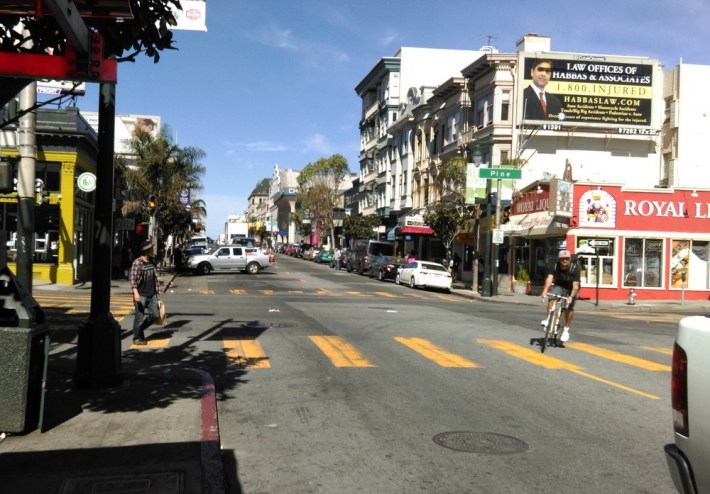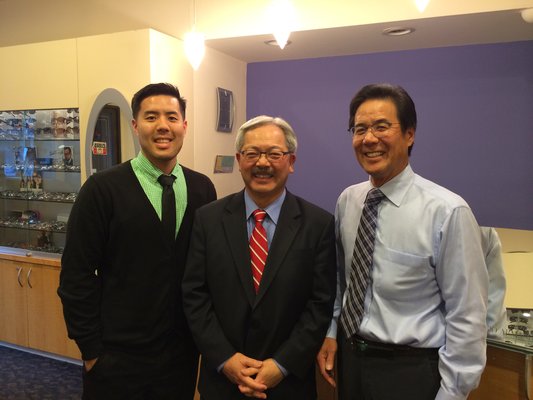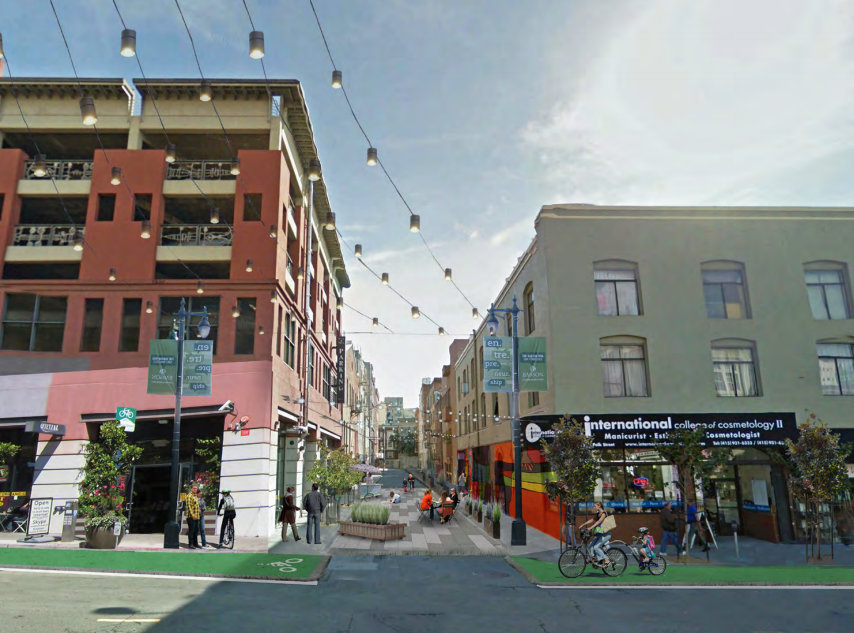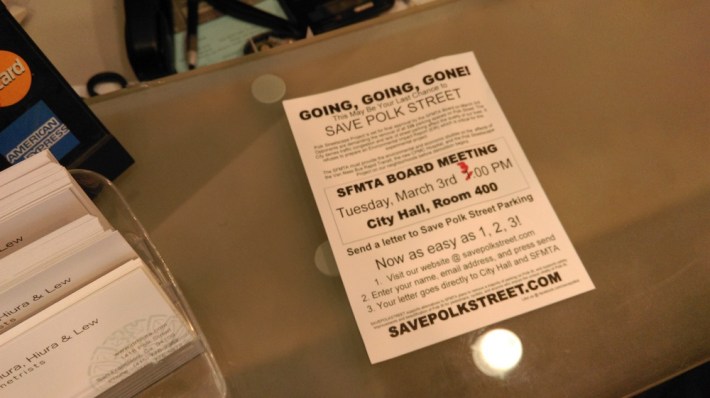
The SFMTA has nixed a block of protected bike lane planned on Polk Street, where merchants including Mayor Ed Lee's optometrist have vocally opposed it to preserve car parking.
The raised, protected bike lane between California and Pine Streets was removed from Polk's plans six months after they were presented at the final public open house. SFMTA Director Ed Reiskin ordered the reduction, as shown in emails [PDF] obtained by Madeleine Savit, who founded Folks for Polk to advocate for a safer street. Reiskin and the SFMTA Board of Directors are mayoral appointees.
The Polk redesign, which is up for a vote by the SFMTA Board of Directors on Tuesday, has been fiercely opposed by a group of merchants called "Save Polk Street," which has spread misinformation in its campaign to preserve parking. Under the proposed plan, partial bike lanes would be installed by removing about 30 percent of the 320 parking spaces on Polk, or 8 percent of parking spaces within a block of the street. About 85 percent of people on Polk arrive without a car.

Drs. Hiura and Hiura Optometrists, which posted a photo on its Yelp page of Mayor Lee in "his new frames," had a "Save Polk Street" flyer on its reception desk when Streetsblog visited the business today.
Dr. Ronald Hiura told Streetsblog that he has "talked to the mayor and SFMTA Board members personally," which "could possibly" have driven the removal of the bike lane on his block. "I was happy to see that they have revised that one-block issue," he said.
Streetsblog asked Mayor Lee today if he had taken any action on the Polk plan, noting the protests from some merchants over losing parking. He didn't say he'd pushed the SFMTA to change the plan. "I've been meeting with the MTA," said Lee. "They're the experts. They have so many issues to balance, and I just want to make sure I embrace a very strong balancing process."
"I've heard from many different groups," Lee told Streetsblog. "I know we want to make the streets safer, make it bike-friendly, small businesses don't want to lose parking for their constituents... I can't have a particular position on it except to endorse the most balanced approach that they have because there's issues that should not be in conflict. We shouldn't promote bicycle safety over pedestrian safety over cars and parking. I think they're all going to be important."

"We have to look at the future -- what is it that thoroughfare suggests to us? And how do we take a look at that future and [find] the safest, expedient route that balances the different modes of transportation people have, but also supports the businesses at the same time. If it takes more time, then I'm going to suggest that more time should be taken."
Construction on the project has already been delayed by a year, and the original plans for protected bike lanes on Polk were dropped for at least 10 of 20 blocks.
Under the plan presented last March, which wasn't expected to change significantly, Polk would only get a protected bike lane on the northbound side between McAllister and California Streets, with a buffered, painted bike lane on the other side. On the northern stretch, between California Street and Broadway, the southbound direction will have a painted bike lane running between parked cars and moving cars. Northbound will have a part-time bike lane, with parking banned along the curb during morning rush hours. During other times, the only provision for cycling northbound will be green-backed sharrows in the traffic lane.
With the latest revision, the unprotected stretch will be extended another block south to Pine. SFMTA Director Reiskin told Streetsblog, "Having heard some pretty strong concerns about the proposal for that block, we thought it best to change it." He noted that the SFMTA had received opposition letters from merchants on that block in 2013, one of them from Hiura Optometrists.
When asked if the mayor's office has taken an active interest in the project, Reiskin said he's "been keeping the mayor and supervisors up to date on what we're doing, and they seem satisfied with the direction we're going, understanding there's a lot of concern on multiple sides of the issue. A lot of people think we're doing too much, a lot of people think we're not doing enough."
When asked why the plan was changed six months after the final open house, Reiskin said, "We're looking at primarily safety data... but we're constantly taking all of the different pieces of data and information and trying to use them to shape the project and make it the best project possible."
The most significant new information to come out recently was new crash data showing that Polk is even more dangerous than previously thought. According to police data, there were at least 149 bicycle-related crashes between November 2006 and December 2014, or about 1.5 per month. Since November 2011, there were 56 such crashes -- seven of them at Pine, more than any other intersection on the corridor. Overall, about 75 percent of bike and pedestrian crashes on Polk occur between McAllister and Pine.
In 2013, Streetsblog happened upon the aftermath of a bike crash at Polk and Pine while filming a video. A man who worked at Royal Liquors, which sits on the adjacent corner and has signed an opposition letter to the SFMTA, told us we could not film the street, attempted to block our camera, and told us to delete our footage. He repeatedly insisted that the bicycle rider was at fault, although the driver who hit him apparently veered into the oncoming traffic lane and fled the scene.

Hiura, the mayor's optometrist, said he wants to keep parking in front of his business available for elderly patients who drive, and that the bike lanes won't make the street safer or increase ridership.
Hiura said he felt endangered by the bike traffic when he visited Copenhagen, Denmark, where a broad range of residents -- including the elderly -- get around on raised bike lanes and traffic-calmed streets that criss-cross the city. With an urban population of over 1,200,000, Copenhagen's overall traffic deaths are on a trend of decline, with about 10 to 15 per year [PDF] (compared to SF's 28 last year, and 34 in 2013). Thirty-six percent of trips in Copenhagen were made by bike as of 2012.
"This whole thing that the SFMTA is doing with San Francisco, I don't feel like they're honoring the elderly," said Hiura. "I think their direction is trying to make San Francisco like New York."
In New York City, three years after protected bike lanes were implemented on six street segments, the city found that total traffic injuries dropped 20 percent and pedestrian injuries dropped 22 percent. On Broadway, bike volumes jumped 108 percent while bike crashes with injuries fell 18 percent.
New York's retail streets that got protected bike lanes also tended to see higher sales increases than comparable streets that didn't. (No similar survey in SF is available yet.)
In SF, surveys done on commercial streets in walkable neighborhoods, including Polk, have consistently found that merchants vastly overestimate how many of their customers drive, and that those who do drive spend the least. A city survey released a year ago also found that out of 140 respondents who use Polk, 48 said “the biggest challenge affecting Middle Polk” was the “unsafe environment for pedestrians and cyclists.” It was the top choice, while “not enough parking” was chosen by 16 respondents, making it the third-most selected choice.
If Mayor Lee did put pressure on the SFMTA to remove a bike lane for his optometrist, it wouldn't be the first time he's used his leverage to undo a smart decision at the agency in the name of parking. Last year, he got the SFMTA Board to repeal Sunday parking meters.
SFMTA Board member Cheryl Brinkman said she hopes the board will demand a bolder, safer plan for Polk on Tuesday.
"This project has really called into everybody's mind why we have an MTA board that should be above politics on things like this," she said. "Hopefully, this board is going to call for the safest project we can have regardless of the impact on parking for private cars."





